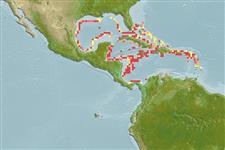>
Perciformes/Bembropoidei (Duckbill flatheads) >
Bembropidae (Duckbill flatheads)
Etymology: Bembrops: Greek, bembras, -ados = a kind of anchovy m+ Greek, ops = appearance (Ref. 45335); magnisquamis: Specific name from the Latin 'magnus' meaning large and 'squama' meaning scale..
More on author: Ginsburg.
Environment: milieu / climate zone / depth range / distribution range
Οικολογία
Θαλασσινό(ά) βαθύβιο(ς); εύρος βάθους 350 - 465 m (Ref. 13203). Deep-water
Western Central Pacific: Caribbean Sea.
Μέγεθος / Βάρος / Age
Maturity: Lm ? range ? - ? cm
Max length : 10.5 cm SL αρσενικό/απροσδιόριστο; (Ref. 13203)
Ραχιαίες άκανθες (συνολικά) : 6; Μαλακές ραχιαίες ακτίνες (συνολικά) : 15 - 16; Μαλακές εδρικές ακτίνες: 17. Color in alcohol uniformly light yellowish brown. Snout relatively short, almost equal to eye diameter, with scales on lateral and dorsal surfaces including the area in front of eye. Upper jaw extending behind anterior margin of eye. Maxillary tentacle long, tapering at the end. Lateral line descending gradually in region of pectoral fin, separated from origin of first dorsal fin by 2-4 rows of scales, from origin of anal fin by 4-5, and from insertion of anal fin by 2. Spines of first dorsal fin not elongated (Ref 13203).
Life cycle and mating behavior
Maturities | Αναπαραγωγή | Spawnings | Egg(s) | Fecundities | Προνύμφες
Das, M.K. and J.S. Nelson, 1996. Revision of the percophid genus Bembrops (Actinopterygii: Perciformes). Bull. Mar. Sci. 59(1):9-44. (Ref. 13203)
IUCN Red List Status (Ref. 130435)
Threat to humans
Harmless
Human uses
Εργαλεία
Special reports
Download XML
Διαδικτυακές πηγές
Estimates based on models
Preferred temperature (Ref.
123201): 10.2 - 13.8, mean 12.2 °C (based on 8 cells).
Phylogenetic diversity index (Ref.
82804): PD
50 = 0.5000 [Uniqueness, from 0.5 = low to 2.0 = high].
Bayesian length-weight: a=0.00372 (0.00153 - 0.00904), b=3.10 (2.89 - 3.31), in cm total length, based on LWR estimates for this (Sub)family-body shape (Ref.
93245).
Τροφικό Επίπεδο (Ref.
69278): 3.8 ±0.4 se; based on size and trophs of closest relatives
Fishing Vulnerability (Ref.
59153): Low vulnerability (10 of 100).
